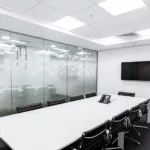Town-hall style meetings have been around since humans decided to start gathering in centralized locations to discuss important matters. Their premise is simple: It’s a time and space for leaders to communicate with constituents, partners and employees; for individuals to commune with the large group and vice versa. A true town hall meeting includes plenty of give-and-take between participants at all levels.
Thanks to advances in modern technology, town hall meetings have been trending toward interactivity, efficiency and culture-building. Consider these five important functions of modern town hall meetings next time you’re planning and executing a large-scale meeting for your organization.
Fostering Company Community
Company culture has become somewhat of a buzzword in the corporate world. Why? Because organizations have realized poor company culture is associated with high turnover rates and decreased productivity. Conversely, strong company culture often entices employees to stick around and grow with the organization, plus encourages strong new candidates to apply.
As much as leaders like to believe they can forge company culture by sheer willpower and programming alone, it actually takes a secret ingredient: sense of community. As the Workforce Institute writes, “Communities are successful because their members are successful. For a community to thrive, it needs care and attention. This means building and growing a community is about people, not programs.”
Town-hall meetings are the perfect time to establish a living, breathing community—one that reaches well beyond mere goals and objectives written in a memo.
Expanding Top-Down Communication
How connected do employees feel with the leadership? Town hall meetings are a great time to break down barriers between high-level employees and everyone else, whether leaders take the physical stage or reach employees via live videoconferencing technology. But truly innovative organizations push past a traditional top-down model of communication and decision-making. How? By getting interactive.
Gathering Valuable Feedback
Employees are full of insights, opinions and bright ideas. Town halls are the perfect time and place to solicit them. Integrating interactive Google Slides into a presentation deck, for instance, allows companies to gather feedback on the spot. As long as employees have access to a web-enabled device, they can anonymously contribute to polls, word clouds and Q&A sessions. Organizations can then refer to this collected intel long after the actual town hall meeting ends.
Brainstorming New Strategies
To put it plainly, town hall meetings are a great time to ask: “Here’s where we stand, but where are we headed? How can we get there?” One nonprofit community advisor demonstrated this principle in action for Government Technology: After two bike-related deaths within a week in a Colorado community, a town hall meeting helped organizers hold a brainstorming session. Thanks to electronic polling technology, they walked out of the meeting with a concrete list of actions, some of which the community has since implemented to boost bike safety.
Building Valuable Connections
Town hall meetings are a great chance for employees to leave their workspaces, shake up their daily routines and connect with new colleagues. You want participants to leave the session energized and inspired—not drained and relieved it’s over. Make sure your organization is creating opportunities for employees to communicate and collaborate, whether it’s a five-minute icebreaker activity to kick off a presentation or breakout sessions to cap off a keynote speech. Interpersonal connections within a business only strengthen its fabric, so it’s worthwhile to prioritize social growth and, yes, even just plain fun.
It’s time to take advantage of the full breadth of what a great town hall meeting can catalyze: a sense of community, a forum for feedback and a place to actively shape the future of your organization.








